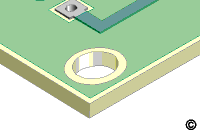No. 3.3.2
Hole Repair, Transplant Method
OUTLINE
This method is used to repair severe damage to a hole or to modify the size,
shape or location of an unsupported tooling or mounting hole. The hole may have
component leads, wires, fasteners, pins, terminals or other hardware run through
it. This repair method uses a dowel of matching board material and high strength
epoxy to secure the dowel in place. After the new material is bonded in place a
new hole can be drilled. This method can be used on single sided, double sided
or multilayer circuit boards and assemblies.
CAUTION
Damaged inner-layer connections may require surface wire adds.
TOOLS & MATERIALS
Base Board Repair Kit
Base Material Rod
Cleaner
End Mills
Epoxy
Knife
Micro-Drill System
Microscope
Mixing Sticks
Oven
Precision Drill System
Razor Saw
Tape, Kapton
Wipes
PROCEDURE
- Clean the area.
- Drill out the damaged or improperly sized hole using a carbide end mill or
drill. Mill the hole using a precision drill press or milling machine for
accuracy. The diameter of the cutting tool should be as small as possible yet
still encompass the entire damaged area. (See Figures 1 and 2).
NOTE
Abrasion operations can generate electrostatic charges.
- Cut a piece of replacement base material rod. Base material rod is made from
FR-4 dowel stock. Cut the length approximately 12.0 mm (0.50") longer than
needed.
- Clean the reworked area
- Use Kapton tape to protect exposed parts of the circuit board bordering
the rework area
- Mix the epoxy.
- Coat both the dowel and the hole with epoxy and fit together. Apply
additional epoxy around perimeter of new material. (See Figure 3). Remove excess
epoxy.
- Cure the epoxy per Procedure 2.7 Epoxy Mixing and Handling.
CAUTION
Some components may be sensitive to high temperatures.
- Remove Kapton tape and cut off the excess material using the razor saw. Mill or
file the dowel flush with the board surface. (See Figure 4).
- Complete the procedure by redrilling holes and adding circuitry as required.
(See Figure 4).
NOTE
Apply surface coating to match prior coating as required
- Clean the reworked area.
EVALUATION
- Visual and dimensional examination of the reworked area for conformance to
drawings and specifications.
|
|
|
Solutions Across the Board
TM
|
|
|
|
Product Class: R/W
Skill Level: Expert
Conformance Level: High
Revision: E
Revision Date: Jul 7, 2000
Repair Service Charge

Damaged Hole, Non Plated

Figure 1: New hole is milled to encompass entire damaged area.

Figure 2: Precision Drill System for accurate hole drilling and milling.

Figure 3: Place replacement dowel in position and bond with epoxy

Figure 4: Cut off excess material and redrill holes as required.

Figure 5: Micro-Drill
System.
|
Tricks of the Trade
This is a challenging, but highly reliable rework/repair
procedure. Should not to be attempted by rookies. Call for assistance with the
dowel material. We recommend Pre-packaged
Epoxy to bond the replacement dowel in place. Mix a Color Agent
in with the Epoxy if needed.
You'll need to drill out the hole accurately. We recommend a Precision Drill fitted with a carbide
End Mill for the initial drilling.
|
|
|
